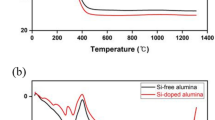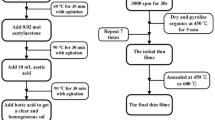Abstract
The influence of titanium doping on the electric properties of amorphous alumina (Al2O3) films prepared by sol–gel technology was investigated. EDX mapping analysis indicates that the titanium cations are uniformly distributed in the film as Al2−xTixOy. The XPS analysis reveals that the titanium exists in the form of TiO2. The breakdown strength of the doped film can be much enhanced by the titanium doping. The dielectric strength of undoped Al2O3 films is 3.4 MV/cm, while the breakdown strength of the 10 % Ti-doped Al2O3 films is 5.3 MV/cm. Compared with the undoped Al2O3 films, the soft breakdown of Ti-doped Al2O3 films is gradually suppressed with the increasing of the titanium doping amount. Especially, there is hardly any soft breakdown observed for 10 % Ti-doped Al2O3 films.






Similar content being viewed by others
References
Segda BG, Jacquet M, Besse JP (2001) Elaboration, characterization and dielectric properties study of amorphous alumina thin films deposited by r.f. magnetron sputtering. Vacuum 62:27–38
Shamala KS, Murthy LCS, Rao KN (2004) Studies on optical and dielectric properties of Al2O3 thin films prepared by electron beam evaporation and spray pyrolysis method. Mater Sci Eng B 106:269–274
Lin HC, Ye PD, Wilk GD (2005) Leakage current and breakdown electric-field studies on ultrathin atomic-layer-deposited Al2O3 on GaAs. Appl Phys Lett 87:182904
Hickmott TW (2000) Voltage-dependent dielectric breakdown and voltage-controlled negative resistance in anodized Al–Al2O3–Au diodes. J Appl Phys 88:2805–2812
Hu BF, Yao MW, Yang PF, Shan W, Yao X (2013) Preparation and dielectric properties of dense and amorphous alumina film by sol–gel technology. Ceram Int 39:7613–7918
Yao MW, Chen JW, Yang PF, Shan W, Hu BF, Yao X (2013) Preparation and breakdown property of aluminum oxide thin films deposited onto anodized aluminum substrate. Ferroelectrics 455:21–28
Dover RBV (1999) Amorphous lanthanide-doped TiOx dielectric films. Appl Phys Lett 74:3041–3043
Fujikawa H, Taga Y (1994) Effects of additive elements on electrical properties of tantalum oxide films. J Appl Phys 75:2538–2544
Salam KMA, Fukuda NS (2003) Effects of additive elements on improvement of the dielectric properties of Ta2O5 films formed by metalorganic decomposition. J Appl Phys 93:1169–1175
Lau WS, Tan TS, Babu P, Sandler NP (2007) Mechanism of leakage current reduction of tantalum oxide capacitors by titanium doping. Appl Phys Lett 90:112903
Biesinger MC, Lau LWM, Gerson AR, Smart RSC (2010) Resolving surface chemical states in XPS analysis of first row transition metals, oxides and hydroxides: Sc, Ti, V, Cu and Zn. Appl Surf Sci 257:887–898
Rath C, Mohanty P, Pandey AC, Mishra NC (2009) Oxygen vacancy induced structural phase transformation in TiO2 nanoparticles. J Phys D Appl Phys 42:205101
Seal S, Kuiry SC, Bracho LA (2001) Studies on the surface chemistry of oxide films formed on IN-738LC superalloy at elevated temperatures in dry air. Oxid Met 56:483–603
Kim SK, Choi G-J, Lee SY, Seo M, Lee SW, Han JH, Ahn H-S, Han S, Hwang CS (2008) Al-Doped TiO2 films with ultralow leakage currents for next generation DRAM capacitors. Adv Mater 20:1429–1435
Jackson JC, Robinson T, Oralkan O, Dumin DJ (1998) Differentiation between electric breakdowns and dielectric breakdown in thin silicon oxides. J Electrochem Soc 145:1033–1038
Kim H, Troczynski T (2007) Thick alumina dielectric films on aluminium though chemically bonded composite sol–gel. Ceram Int 33:333–336
Liu D, Clark SJ, Robertson J (2010) Oxygen vacancy levels and electron transport in Al2O3. Appl Phys Lett 96:032905
Perevalov TV, Tereshenko OE, Gritsenko VA, Pustovarov VA, Yelisseyev AP, Park C, Han JH, Lee C (2010) Oxygen deficiency defects in amorphous Al2O3. J Appl Phys 108:013501
Ganesan K, Ilango S, Shanmugam M, Baroughi MF, Kamruddin M, Tyagi AK (2013) Pre- and post-breakdown electrical studies in ultrathin Al2O3 films by conductive atomic force microscopy. Curr Appl Phys 13:1865–1869
Wit HJ, Wijenberg C, Crevecoeur C (1976) The dielectric breakdown of anodic aluminum oxide. J Electrochem Soc 123:1479–1486
Depas M, Nigam T, Heyns MM (1996) Soft breakdown of ultra-thin gate oxide layers. IEEE Trans Electron Dev 43:1499–1504
Acknowledgments
This work is supported by the Ministry of Science and Technology of China through 973-project (Grant Number 2015CB654601), International Science and Technology Cooperation Program of China (Grant Number 2013DFR50470) and National Science Foundation of China (Grant Number 51272177).
Author information
Authors and Affiliations
Corresponding author
Rights and permissions
About this article
Cite this article
Yao, M., Xiao, R., Peng, Y. et al. The influence of titanium doping on the electric properties of amorphous alumina films prepared by sol–gel technology. J Sol-Gel Sci Technol 74, 39–44 (2015). https://doi.org/10.1007/s10971-014-3568-1
Received:
Accepted:
Published:
Issue Date:
DOI: https://doi.org/10.1007/s10971-014-3568-1




